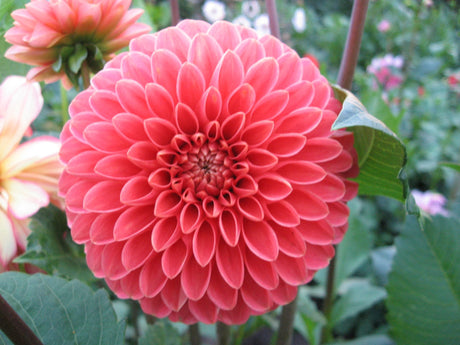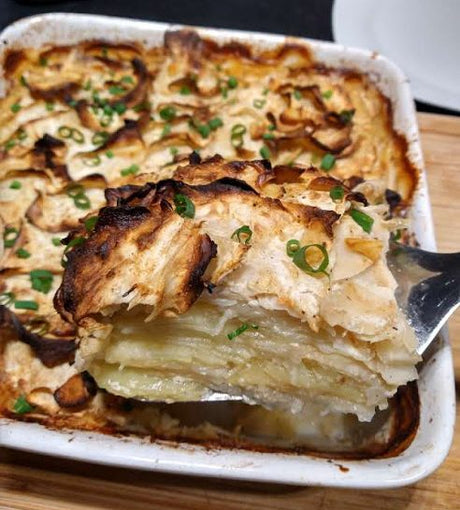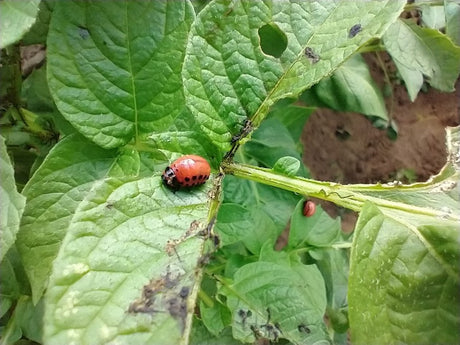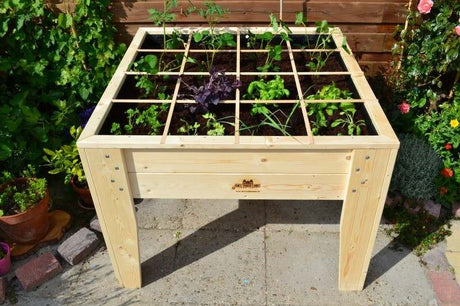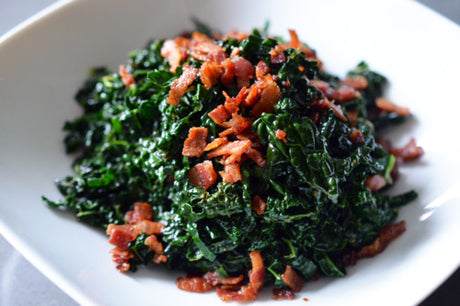Even a seasoned gardener won't believe their eyes when they dig their first bulb out of the ground. Growing elephant garlic isn't that difficult, especially after reading this growing guide. Elephant garlic is cultivated worldwide, including in China, where it's widely grown.
Elephant garlic, also known as giant garlic or with the Latin name Allium ampeloprasum var. ampeloprasum , is a unique variety of garlic. It is known for its large bulbs with a mild yet complex flavor. Elephant garlic is especially known for its large bulb, which is much larger than that of regular garlic. The plant consists of a few large, individual cloves instead of many small cloves. The flavor is milder than regular garlic, making it suitable for those who prefer a milder garlic.
The plant also has a sturdy stem that resembles a leek. This garlic is not only a delicious addition to your dishes but also relatively easy to grow. In this growing guide, you'll learn everything you need to know about successfully growing elephant garlic.
Introduction to Elephant Garlic
Elephant garlic is such a wonderful discovery that we all need to try in our gardens! This extraordinary giant of the onion family ( Allium ampeloprasum var. ampeloprasum , but let's just call it our big friend) is related to the leek and often mistaken for regular garlic—but just wait until you see its impressive bulbs! We're talking about real garlic bulbs that will amaze you, with a few hefty cloves you can barely hold in one hand. And the flavor? It's so wonderfully mild yet rich that you can use it in so many ways—from warm, comforting soups to casseroles that will make your whole house smell wonderful. The great thing is that you can plant elephant garlic in both early spring and fall, so you have complete freedom as to when you want to start this adventure. Whether you're just starting out in the garden or have been digging in for years, elephant garlic is such a rewarding, easy-to-grow crop that will truly surprise and enrich your garden (and your kitchen).
Soil requirements for elephant garlic
Elephant garlic prefers well-drained, fertile soil. Ensure the soil is rich in organic matter. It's advisable to amend the soil before planting with compost or well-rotted manure for nutrition and better drainage. The soil pH should be between 6.0 and 7.0, which is ideal in most gardens.

Light and Temperature
Elephant garlic thrives in a full-sun spot. Choose a spot in your garden with at least 6 to 8 hours of sunlight per day. This variety is winter-hardy and can withstand temperatures (including frost), meaning it can be planted in early spring or autumn.
Cultivation period
It's best to plant this garlic in the fall or early in the year. You can expect a harvest in early summer. If you plant in the fall, you can expect even larger bulbs of elephant garlic.
Use our seed potatoes for this, which are often available in the fall. It's important to carefully plant the seed potatoes at the correct spacing for good growth.
You can expect the harvest in early summer. If you planted in the fall, you can expect even larger elephant garlic bulbs . Small bulbs or cloves can develop into large, full-sized bulbs over the course of the growing season.
Planting instructions
|
Choose the elephant garlic clovesFor best results, use large, healthy cloves. Avoid small or damaged cloves. |
Depth and distancePlant the loose cloves about 10-15 cm deep with a distance of 20-30 cm between the cloves. |
Organic materialAdd some mulch after planting to keep the soil moist and minimize weed growth. |
Watering
Elephant garlic needs constant moisture, especially during the growing season. Make sure the soil never feels too dry . However, avoid overwatering, as this can lead to root rot.
Weed and Pest Control
Keep the area around the onion weed-free. Weeds can compete for nutrients and water. Pests such as aphids and thrips should also be monitored. Use organic pesticides if necessary.
Harvesting elephant garlic
Harvesting elephant garlic is easy in three steps, provided you choose the right time and handle it carefully to avoid damaging the bulbs. Follow these steps:
- Step 1: Choose the right time: Elephant garlic is ready to harvest when the leaves begin to yellow and die, usually in late summer or early fall (about 8-10 months after planting). This is a sign that the bulbs are mature. Don't wait too long, as too many wilted leaves can reduce bulb quality.
- Step 2: Carefully dig around the bulb: Use a garden fork or shovel to carefully dig around the plant, about 4-6 inches (10-15 cm) from the base of the plant to avoid damaging the roots and bulb. Pry the bulb loose from the ground and pull the plant out of the ground, leaves attached.
- Step 3: Let the bulbs dry. Gently clean the bulbs by shaking off any excess soil, but avoid washing them. Hang the bulbs or place them in a well-ventilated area, such as a dry shed or garage, to dry. After two to three weeks, they will be ready to store or use. These steps will help preserve the quality of the elephant garlic and ensure optimal flavor and shelf life.


Storing elephant garlic
There are several ways to store elephant garlic to maximize its freshness and flavor. Here are some storage tips:
At room temperature
Store in a cool, dry place with good air circulation, such as a cupboard or pantry. Avoid damp places like the refrigerator, as this can lead to mold and sprouting. In a dark, well-ventilated space, elephant garlic can last up to 3 months.In the refrigerator (only for peeled or chopped garlic)
If you already have peeled or chopped cloves, you can store them in an airtight container in the refrigerator. Make sure the garlic is dry and use it within a week, as it quickly loses flavor and quality.Freeze
For longer storage, you can freeze giant garlic. Peel the cloves and finely chop or puree them. Pack the garlic in airtight bags or small containers and freeze them. This way, your harvest will last up to 6 months, but keep in mind that the texture will change slightly after thawing.Store in oil (with caution)
You can store this type of garlic in oil for a short time (a few weeks), provided it's refrigerated. However, this must be done carefully to prevent the growth of bacteria, such as botulism. Do not store garlic in oil for longer than a week and make sure it stays refrigerated.Drying or smoking
Another way to extend the shelf life of giant garlic is by drying or smoking it. You can dry it in a dehydrator or air-dry it. Dried garlic can be ground into garlic powder or stored whole cloves in an airtight container.
These methods will help you maximize the flavor and quality of your elephant garlic, depending on how quickly you plan to use it.
Dishes with elephant garlic
Elephant garlic, also known as giant garlic, has a milder flavor than regular garlic and is delicious in a variety of dishes.
Here are my top 5 best dishes in which elephant garlic really shines:
Roasted Elephant Garlic as a Side Dish
Cut a bulb of elephant garlic in half horizontally, drizzle with olive oil, salt, and pepper, and roast in the oven (about 45 minutes at 180°C). The garlic will soften and develop a sweet, mild flavor. Delicious spread on bread or with grilled vegetables.Pasta with Elephant Garlic and Lemon
Make a simple pasta dish by heating olive oil with thinly sliced elephant garlic until lightly golden. Add lemon juice, lemon zest, a pinch of red pepper flakes, and your favorite fresh herbs (like basil or parsley). Toss this with cooked pasta and, if desired, Parmesan cheese for a fresh, slightly spicy pasta dish.Elephant Garlic Aioli
Make homemade aioli by finely puréeing elephant garlic and mixing it with mayonnaise, a little lemon juice, salt, and pepper. This gives a subtle garlic flavor that's delicious with fries, grilled vegetables, and bread.Creamy Elephant Garlic Soup
Roast elephant garlic with onion and carrot, puree it, and add it to a base of vegetable stock and cream for a creamy, smooth garlic soup. Garnish with fresh herbs like chives or thyme. The elephant garlic gives the soup a mild, rich flavor.Grilled Chicken with Elephant Garlic and Rosemary
Make a marinade with olive oil, finely chopped elephant garlic, fresh rosemary, lemon juice, and black pepper. Marinate chicken breasts or thighs in this mixture and grill or bake the chicken. The elephant garlic adds a subtle garlicky note that complements the rosemary and lemon perfectly.
Each of these dishes beautifully showcases the mild, aromatic flavor of elephant garlic. Its milder flavor makes it a perfect addition to both subtle and bold dishes.
Benefits of Elephant Garlic
At Plukkers, we can't emphasize it enough: elephant garlic is a true gem for your vegetable garden and kitchen! This mild giant gives your dishes that wonderfully soft garlic flavor without being overpowering. Perfect for those looking for that subtle garlic note that gives your meal that little something extra. And let's be honest: those large, separate cloves and bulbs make cooking so much easier! No more fiddling with tiny cloves, just get to work with those generous chunks. With your hands in the soil and later in the pan—that's how truly delicious cooking should be. But there's more: this hardy gem is packed with antioxidants and has wonderful anti-inflammatory properties that will make your body happy. The best part? Elephant garlic thrives in our Dutch and Belgian gardens and is ready to be harvested year-round to enhance your dishes. Thanks to its mild flavor, you can definitely use a little more—experiment, taste, and enjoy! Elephant garlic not only brings convenience and flavor to your kitchen, but also health and gardening happiness together in one beautiful story.
Finally
With this growing guide, you'll be well prepared to cultivate elephant garlic in your garden. It requires some attention, but with the right conditions and care, you'll bring a burst of flavor into your kitchen.
In cooking, use the same number of elephant garlic cloves as you would regular garlic. Because of the milder flavor, it's the same amount. Good luck and enjoy the delicious dishes you can make year-round with your homegrown elephant garlic!
These are my favorites for growing elephant garlic:








